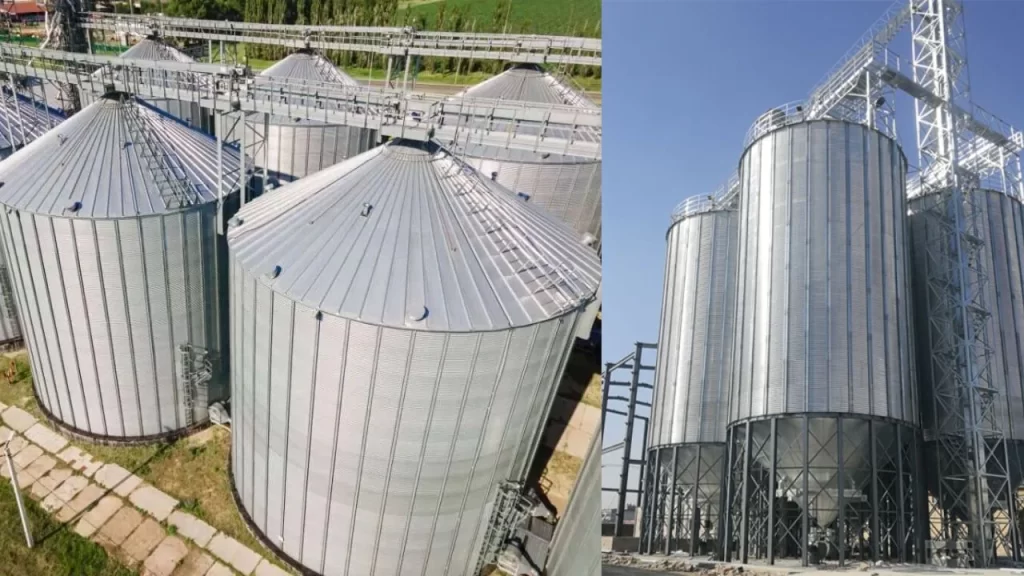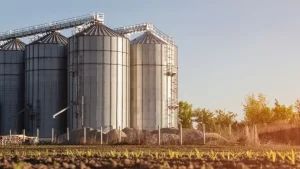When considering grain storage solutions, two prominent types of silos come to mind: Hopper Bottom Silos and Flat Bottom Silos. Each type has its unique design, advantages, and applications, making them suitable for different operational needs. Understanding these differences can help you make an informed decision for your grain storage requirements.

What is a Hopper Bottom Silo?
A Hopper Bottom Silo features a conical or funnel-shaped base that allows grain to naturally flow toward the center, where it can be easily discharged. The design of the hopper bottom facilitates efficient unloading by gravity, making it an excellent choice for quick discharge of materials without needing a lot of mechanical intervention. This type of silo is generally used for smaller-scale grain storage and is ideal for grains that flow freely.
1. Hopper Bottom Silo
- Shape and Structure: As the name suggests, these silos have a conical or “hopper” shaped bottom that funnels material towards a central discharge point. This design helps in the smooth and efficient flow of stored material.
- Material Flow: The hopper shape ensures that the stored material is directed to the bottom, where it can be discharged easily. The angle of the cone is crucial to avoid material blockages or bridging.
- Capacity: While hopper bottom silos can be relatively smaller in capacity compared to flat-bottom silos, they are ideal for materials that need to flow freely, like grain, cement, and other powders.
- Usage: Commonly used for bulk storage of grains, feeds, or powdery materials, as their structure allows for easy unloading through gravity.
- Foundation and Support: These silos require a stronger foundation due to the concentrated load at the base of the cone, which typically requires more support.
What is a Flat Bottom Silo?
In contrast, Flat Bottom Silos are cylindrical silos with a flat base. These silos are designed for larger storage capacities and are typically used for storing large volumes of grain over extended periods. Unlike hopper bottom silos, flat bottom silos rely on additional unloading systems, such as conveyors, augers, or aeration, to discharge stored grains.
2. Flat Bottom Silo
- Shape and Structure: Flat-bottom silos have a level base, allowing for a uniform distribution of material within the silo. The shape is cylindrical, and the storage area is usually wider in comparison to the hopper-bottom silo.
- Material Flow: These silos rely on aeration or mechanical unloading methods to empty the material, which can make them more suitable for long-term storage of bulk materials that don’t need to be continuously discharged.
- Capacity: Flat bottom silos generally have a higher capacity than hopper-bottom silos, making them ideal for large-scale operations.
- Usage: These are commonly used in industries like agriculture, grain storage, cement, and large-scale processing facilities, where large quantities of material are stored for extended periods.
- Foundation and Support: The load is spread more evenly across the foundation, so the structural requirements for a flat-bottom silo can be less intensive than for a hopper-bottom silo.
Advantages of Hopper Bottom Silos:
- Efficient Unloading: The conical shape of the hopper bottom silo allows for natural gravity flow of materials, making it easier and faster to unload. This is especially useful for materials like grains and powders that flow freely.
- Space-Saving: Because of their design, hopper bottom silos are typically more compact and can be used in smaller spaces or areas with limited ground area.
- Prevention of Material Blockage: The funnel shape ensures that materials are funneled to the center, minimizing the chances of materials becoming stuck or bridged, which can happen in flat-bottom silos.
- Versatile for Various Materials: Hopper bottom silos are ideal for materials that tend to flow easily, such as grains, powders, and small pellets, making them very versatile in industries like agriculture, cement, and food processing.
- Lower Maintenance: The gravity-driven flow of material reduces the need for additional mechanical unloading systems, leading to potentially lower maintenance costs.
Advantages of Flat Bottom Silos:
- Higher Storage Capacity: Flat bottom silos typically offer much higher storage capacities compared to hopper bottom silos. This makes them ideal for large-scale industrial applications where bulk storage of materials is required.
- Flexibility in Unloading: These silos can be equipped with various unloading systems, such as conveyors, augers, or aeration systems, which can be customized based on the material type and unloading requirements.
- Long-Term Storage: Flat bottom silos are better suited for long-term storage of bulk materials. They can hold a variety of materials, including those that are more difficult to unload or those that need controlled conditions (like temperature or moisture regulation).
- Cost-Effective for Large Operations: For operations requiring massive amounts of storage, flat bottom silos are often more cost-effective due to their larger capacity and ability to store materials for extended periods.
- Stable Structure: The evenly distributed load on the foundation reduces the likelihood of structural failure and provides stability over long periods.
Applications
- Hopper Bottom Silos are commonly used in operations that require frequent unloading, such as feed mills or processing plants. They are particularly beneficial in environments where quick access to stored grains is essential.
- Flat Bottom Silos, on the other hand, are ideal for farms and large-scale storage facilities where long-term storage is a priority. They can also serve as a central hub for grain collection before distribution.
When to Choose a Hopper Bottom Silo for Grain Storage?
If your facility has limited space and requires quick and efficient unloading, a Hopper Bottom Silo may be the best option for your grain storage needs. These silos are well-suited for operations where the unloading process is time-sensitive, and the stored grain is flowing freely. Additionally, hopper bottom silos are great for smaller-scale operations or farms that don’t need to store large volumes of grain.
Best For:
- Small to medium-sized farms
- Operations where quick turnover of grain is required
- Grains that flow freely and require efficient unloading
When to Choose a Flat Bottom Silo for Grain Storage?
For larger operations that require high storage capacity and are storing grain for extended periods, Flat Bottom Silos are the preferred choice. Their larger capacity allows for storing significant quantities of grain, and they provide the flexibility to incorporate aeration and mechanical unloading systems to keep the grain in good condition. Flat bottom silos are ideal for commercial grain storage facilities, co-ops, and large-scale agricultural operations.
Best For:
- Large-scale grain storage operations
- Long-term grain storage needs
- Facilities with a high volume of grain to store and distribute
Conclusion: Making the Right Choice for Your Grain Storage
Choosing between a Hopper Bottom Silo and a Flat Bottom Silo depends on factors such as the scale of your operation, the amount of grain you need to store, and the specific unloading needs you have. If you have a smaller-scale operation with a need for quick, gravity-assisted unloading, a Hopper Bottom Silo will meet your needs. On the other hand, if you’re dealing with large volumes of grain that require long-term storage and more flexibility in unloading, a Flat Bottom Silo is the ideal solution.
Website: https://www.prairiespartners.com/
Mobile: +919310139381
Email: info@prairiespartners.com

